|

 Up
Up 
 Charles Flint
Charles Flint
Remembers

(You are here.)



  Need
to Need
to
find your
bearings?
Try
these
navigation aids:
If
this is your first
visit, please stop by:
Something
to share?
Please:



|
|
Available in Française, Español, Português, Deutsch, Россию,
中文,
日本, and others.
[Ed. – Charles
Ranlett Flint was among the biggest movers and shakers of the late
nineteenth and early twentieth centuries. He was born in Maine in
1850, but moved to New York City and attended the Polytechnic
Institute of Brooklyn, graduating when he was just 18 years old. He
was a partner in a shipping firm by the time he was 21, through
which he made and cultivated world-wide contacts. His business deals
were the stuff of legends; Flint once sold an entire navy to Brazil.
Flint is best remembered as the "father of the trust." He
arranged mergers between companies with similar products or
services, reasoning that a larger, more diversified company would be
healthier than a smaller, specialized business and better able to
weather economic difficulties. In 1892, he created U.S. Rubber from
several smaller companies. In 1899, he formed a candy trust,
American Chicle, and a textile trust, American Woolen. His crowning
achievement was the Computing-Tabulating-Recording Company (CTR),
which he built from three companies -- the International Time
Recording Company of Endicott, N.Y.; the Computing Scale Company of
America of Dayton, Ohio; and the Tabulating Machine Company of
Washington, DC. Each was in possession of advanced technology (for
the time) which, when brought together, spurred more advances and
better products. CTR quickly came to dominate its industry and in
1924 changed its name to International Business Machines --
IBM. Flint remained on the IBM board until he retired at the age of
81.
One of Flint's most famous deals involved the airplane. In
fact, some historians suggest that if Flint had not gotten
involved with the Wright brothers and helped them sell their
airplane, the brothers might have passed into obscurity, their
contribution to aviation half-remembered as an idea before its time.
Nonetheless, he jumped in with both feet and introduced the Wrights'
and their airplane to the world. It was a cordial but not an easy business relationship.
Nor was it especially profitable. But Flint was the midwife who
delivered the infant airplane industry and his efforts had
far-reaching effects, beyond his or the Wrights' expectations.
In this extract from his rambling memoirs, Flint remembers the
Wright Brothers and their "aeroplane," and marvels that such a good idea with so much
potential was such a hard sell.]



|
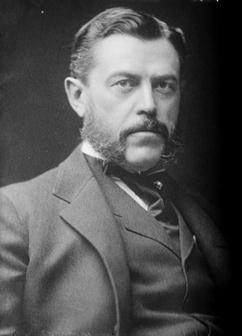
Charles R. Flint
was one of the most powerful men in the world when
he first learned of the Wrights in 1906.
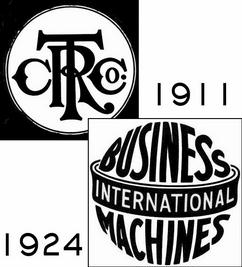
In 1911, Flint founded the high-tech trust that became IBM.
|
|
The aeroplane was
the creation of Wilbur and Orville Wright who, in 1905, were the
first to climb into the skies in a "heavier than air" machine. The
Europeans had talked about what they were doing, and world-wide
publications announced what they expected to do. In 1908 a banquet
was given in Paris to celebrate the success of the Wrights who by
that time had excited considerable jealousy. A speaker, following
Wilbur Wright, known as the man of silence, who had regretted that
he was not an after-dinner orator, remarked that "among the
feathered tribe the best talker and the worst flyer is the parrot."
In the case of
claims for discoveries or inventions, serious questions generally
arise as to rights of priority. For this reason the courts usually
refuse to grant injunctions until patents are adjudicated valid, but
in this case the Wrights were flying while the rest of the would-be
"heavier than air" machine navigators were trying to get off the
ground; so the court naturally made an exception and granted the
Wrights an injunction before adjudication.
The Wrights were
men of high principles and they were public spirited. When a partner
of P. T. Barnum and I elaborated a plan to make a profit of several
hundred thousand dollars by charging admission to see the Wright's
wonder of the air and age, they refused the profit and the public
were admitted free.
England was the
first to seek information about the Wright aeroplane, and as early
as 1904 Colonel Capper, head of the Royal Aircraft Factory, visited
Dayton; but the Wrights were patriotic, and before they would sell
the aeroplane to any other nation they wrote to Washington offering
to turn it over to our government. The reply which they received was
a "snippy" one, and quite in line with the policy which caused
Hotchkiss to go to Paris to exploit his machine gun and which
resulted in our failure to adopt, adapt. exploit, and control the
American submarine inventions of Bushnell, Holland, and Lake. It is
a lamentable fact that most of our soldiers killed in Europe during
the World War were killed by American inventions.
I first took an
intense interest in the Wright aeroplane when our Mr. Ulysses D.
Eddy visited them on Thanksgiving Day, 1906, at their home in
Dayton.
After the United
States Government failed to take advantage of the Wright discovery,
they asked me to offer their aeroplane to England.
In a speech made
in London, Cobb once said "Blood is thicker than water," but owing
to a patronizing speech made by the speaker who preceded him, he
added. "Thank God for the 3,000 miles of water" and abandoned the
speech he had prepared.
The Wrights,
however, without any reservations whatsoever, gave England the
opportunity to be the first to establish a navy of the air. I opened
negotiations with Lord Haldane, the Minister of War, through Lady
Jane Taylor, as I was satisfied that he would give her an immediate
audience. I cabled to her offering for $500,000 ten aeroplanes that
would each fly fifty miles. Haldane replied that a fifty-mile flight
was too short, so I offered him twenty aeroplanes that would each
fly 200 miles for $1,000,000. In reply Haldane told Lady Jane,
"That's Yankee tall talk!" I then offered to exhibit the Wright
aeroplane to Ambassador Bryce, at a club of which I was a member,
about an hour's ride from Washington. I also offered to pay the
costs of demonstration in England and to make a deposit in any bank
in London His Lordship might name to be forfeited in case we did not
make good. His Lordship then suggested to Lady Jane that we send
over plans and specifications. For over two years the British
government had been trying to get information about the Wright
aeroplane; and I sent in cipher an appropriate negative
characterized more by force than by elegance. Soon after I received
the following letter from my Scotch friend Lady Jane:
"You will be
amused that I have been interviewed by order of the Post Office
officially to find out whose code I am using, what the meaning of
certain words is, and in fact to give the show away. The official
sent left me much discomforted by the impracticability of my replies
and fully persuaded of the truth of the Scotch saying, 'Ye can sit
on a rose, ye can sit on a shamrock, but ye canna sit on a thistle!'
"
The Germans were
quicker than any others to recognize the great possibilities of the
Wright aeroplane. It was exhibited by Orville Wright in a park at
Berlin where there were thousands of people to witness the flight.
When the aeroplane was taken across the field there walked in line
behind it the Chief of Staff General Count Moltke, Orville and Miss
Wright, Mrs. Flint, and myself.
After the Berlin
flight, the newspapers stated that the Emperor had extended his hand
to Orville Wright and congratulated him on his achievement. It was
said that the Emperor's words were: "Mr. Wright, you have
revolutionized modern warfare."
I question whether
this statement would have been made by the Emperor under conditions
where it could have been taken seriously. Such a remark might have
been made to disarm suspicion regarding Germany's big aeroplane
preparations. In fact the Germans were generally very diplomatic in
regard to war preparations. They gave out sufficient information to
maintain their prestige in affairs of war in order that German
officers might be the military instructors of the world—even the
Colombian soldiers at Bogota were taught the goose-step march; and
in order to maintain their huge munition plants they encouraged
orders from foreign nations. I was impressed by their prestige when
Major H. R. Lemly, acting with my firm, went to China and other
countries to sell woven military equipment. The fact that the United
States had used it exclusively for five years had little influence;
but when it was stated that the German government was considering
its adoption, government officials became intensely interested.
Not long after the
exhibition of the Wright aeroplane, the Emperor invited to a dinner
twenty prominent men, the majority of whom were interested in the
German dirigible enterprise, and told them that something ought to
be done in Germany to develop the aeroplane. After coffee His
Majesty retired, saying the German equivalent of "It's up to you."
The imperial guests went down into their pockets, including Isador
Loewe who contributed $40,000, and Rathenau who contributed a
smaller sum. In 1908 we sold the Wright invention to a German
company, and in 1909 the Emperor visited the Wright aeroplane
factory in Berlin and inspected the machines.
Some years
earlier, the Krupps had opened negotiations with us for the Lake
submarine inventions. As an evidence of German prestige in affairs
of war, Florio of Naples, hearing of our negotiations, paid our
agent $40,000 in order to secure for Italy a six-month's option on
what we were selling to the Krupps. But after the Germans had
thoroughly satisfied their thirst for knowledge regarding Lake's
inventions, by a careful examination of our plans and
specifications, they omitted the formality of signing on the dotted
line. Florio, inferring from this that the inventions were of no
value, bid good-bye to his $40,000.
We offered the
Wright aeroplane to every minister of war in the world, and wondered
why our offers were unanimously treated with indifference. The
explanation was simply that the Germans did not openly favor
extensive use of the aeroplane for military purposes.
Their apparent
indifference to aerial weapons represented only one phase of a well
calculated plan. The Germans were perfectly willing to furnish the
world with ordinary munitions; but they regarded such munitions as
of secondary importance in comparison with their super-war
armaments, super-aeroplanes, super-submarines, super-cannon—the
cannon which destroyed the Liege forts—the cannon that fired on
Paris at a distance of seventy miles. They realized that world
preparedness was inevitable, but they were confident that the
preparedness of other nations must prove inferior to theirs. While
they amiably forged thunderbolts for foreign purchasers, they
secretly did some super-forging on their own account.
When I visited
Essen, four years before the World War, I was cordially received. I
was shown hospitals and the comfortable homes of their laborers. I
was given a seat at the head of a bountiful board where I tasted
many kinds of their vintage wines, and was escorted by one of
Krupp's directors to Dusseldorf; but this truly Teutonic hospitality
hung like a thick curtain between me and the war preparations that I
would have liked to see. At the Koerting factory in Hanover I
observed that the most advanced submarine and torpedo boat engines
were boarded up so they could not be examined.
In France we
formed a company for the exploitation of the Wright inventions.
Wilbur Wright sailed for France in May, 1908, and his first flight
was made at Le Mains on August 8th, of the same year. The French did
not make much progress in their experimenting with heavier than air
machines until after the Wright flights at Le Mains, when they built
aeroplanes based on Wright inventions, which they called "Wright
machines." Contrary to general opinion, theirs was not an
independent parallel development.
Rear Admiral
Bronson. Mrs. Flint and I witnessed the Orville Wright-Selfridge
flight at Fort Myer, and saw the aeroplane fall. I rushed to the
plane with Mr. Charles-White of Baltimore who was noted for his
powers of observation.
''Lieutenant Selfridge." he said, "will probably die— he does not move his
fingers—but Orville does, and will probably survive."
Selfridge died
that evening, the first man to be killed in a power airship.
Mrs. Flint then
and there made me promise never to go up in an aeroplane, and I have
been as faithful as Irvin Cobb was when leaving the German army for
tide water. The colonel made him give his word of honor not to leave
the squad. Cobb knew enough German to understand the colonel's order
to the captain: "If that man Cobb starts to leave the squad, shoot
him at once!"
Cobb told me
later; "I never kept my word of honor so easily."
In declining
requests to go up, I often referred to a precedent established by
the King of Spain. When we invited His Majesty to ascend at Pau, he
replied, "I have promised the Queen not to go."
The Wrights
invited me to be their guest when Lord Northcliffe visited Dayton to
present Orville Wright with the Albert Medal. After lunch at the
Wright home, where I sat at Orville's left, we adjourned to an
auditorium where there were two thousand people. Governor Cox made a
speech the style of which was somewhat redolent of the stump. After
which Lord Northcliffe stepped forward and in a low but impressive
voice said, "Let us rise and stand in contemplation of the memory of
Wilbur Wright." He then and there won the heartfelt esteem of that
audience and talked to them in a conversational way that recalled
the manner of American Commonwealth
Bryce Northcliffe
requested me to ask in his presence whether the Wrights were being
taken care of by the business men of Dayton who were morally
indebted to them as the founders of their aeroplane prosperity, as
he desired that a financial understanding in the Wrights' favor
should be made clear in his presence.
When on the train
homeward bound, I invited Lord Northcliffe to dine at the Dower
House, formerly occupied by the Lords Baltimore, to meet Justice
McReynolds of the United Slates Supreme Court, Patrick Francis
Murphy, Irvin S. Cobb, Major A. E. W. Mason, Robert H. Davis, and
Captain, now Rear Admiral, Sir Guy Gaunt. Northcliffe's adaptability
was shown by his reply: "I must leave immediately for London, but
give me a rain check."
Whether that was
American slang or whether he had in mind a "wet party" I know not;
but the Dower House was just beyond the prohibition boundary of the
District of Columbia.
I had and have
most pleasant relations with the Wrights. Mrs. Flint and I were of
some service when Orville was injured in the fatal flight with
Selfridge; but the Wrights and I did not always agree. Our
discussions were always frank and both parties evinced a desire to
arrive at wise conclusions, but the Wright brothers retained the
power to decide on business policies. I told them that my experience
had satisfied me that patents in themselves as a rule could not be
relied upon; that there was not one patent in ten thousand which
proved to be a basic or master patent; that success in the
exploitation of inventions depended principally on preempting and
extending the commercial field; that patent litigation was
expensive, in the end generally unsatisfactory, and that it was not
popular, as aggressive patent litigation interfered with the natural
evolution of the art.
The Wrights were
not lucky accidental discoverers: they were patient, intelligent,
industrious investigators. At the outset they made use of existing
scientific data but after their Kitty Hawk and Dayton experiments
they decided that they would have to rely on their own
investigations. They did not attempt to keep their work secret and
sent their tables to Chanute, desiring to assist other
investigators. But if our government had had the wisdom to secure
the Wright aeroplane, Wright secrets would then have become state
secrets.
The Wrights
realized substantial sums from their inventions, but these were
insignificant when compared with their scientific and practical
accomplishment. |
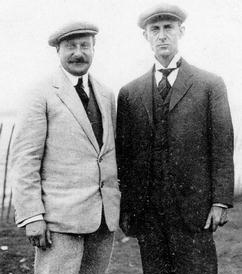
Hart O. Berg (left) was Charles Flint's agent in Europe. He was a
well-connected and well-respected deal-maker, a recipient of the French
Legion of Honor (Ordre national de
la Légion d'honneur). He worked closely with Wilbur
Wright (right) as Wilbur toured Europe making demonstration flights
in 1908 and 1909.
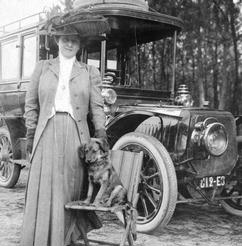
Edith poses with the dog "Flyer." Flyer was a stray that Wilbur
adopted when he was rebuilding his airplane during the summer of
1908. Flyer toured Europe with the Wrights and the Bergs, then Hart
O. Berg and his wife took the dog when the Wrights returned to
America.
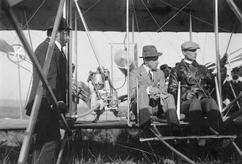
Wilbur Wright in the cockpit with King Alphonso XIII (Spain). Hart
O. Berg looks on. According to Orville Wright, European royalty and
the rich were "thick as thieves" at these flying demonstrations.
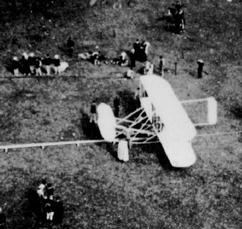
While in Centocelle, Italy, Hart O. Berg snapped this photo of the
Flyer from a tethered balloon.
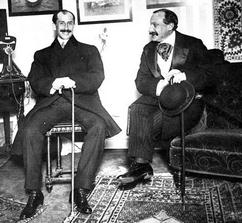
Hart O. Berg and Charles Flint continued to manage the Wright
interests in Europe for many years. The photo shows Berg (right) with Orville
(left) when Orville came to Germany in late 1909.
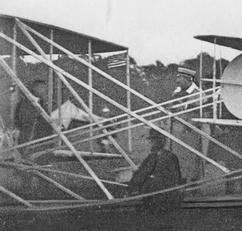
Kaiser Wilhelm II (Germany) visits Orville Wright at Tempelhof Field
in Berlin, Germany.
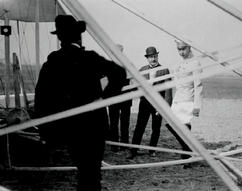
Crown Prince Friedrich Wilhelm
(Germany) also came to watch the flights. For its percieved
aloofness, Germany was vitally interested in aviation.
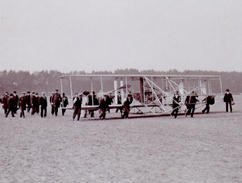
Charles Flint himself occasionally traveled to watch the Wrights fly
and to be at hand for negotiations. He and his wife are somewhere in
this crowd trailing the Wright Flyer as it is towed onto the
Tempelhof flying field in Germany.
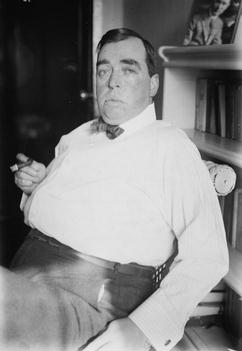
Irvin S. Cobb, whom Charles Flint was so fond of quoting, was a
widely-read journalist and humorist, and a good friend of the
Flints. It's probably a safe bet that Cobb was a great deal funnier
when telling his own jokes than he might seem when Flint re-tells
them.
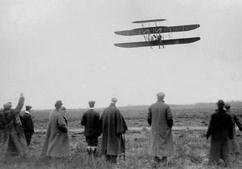
British newspaper magnate Alfred Harnsworth (Lord Northcliffe) waves
at Wilbur as he passes overhead in Pau, France. Northcliffe was a
passionate supporter of new technologies, including automobiles and
airplanes. He wrote several books on "motor sports."
|